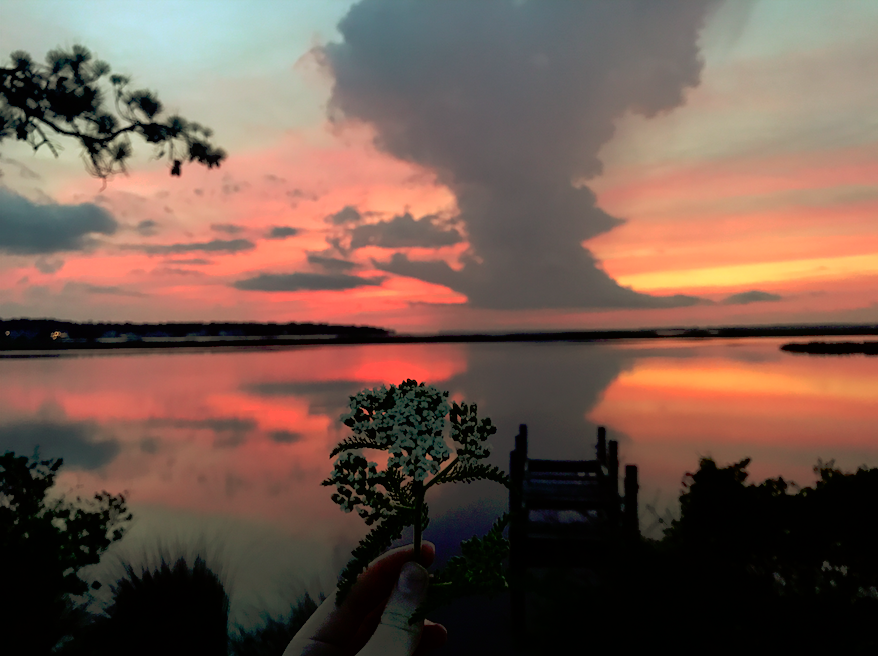
This is the fourth installment in a continuing series on climate change and the North Carolina coast that is part of the Pulitzer Center’s nationwide Connected Coastlines reporting initiative.
Supporter Spotlight
Nearly every year on the Outer Banks brings a new hurricane, storms that wipe out parts of the beach road and flood homes, destroying years’ worth of memories in a single night — experiences that have shaped the perspectives young people on the Outer Banks have on climate science.
“I do believe in sea-level rise,” said Brady Creef, 21, and a rising senior at the University of North Carolina Chapel Hill.

With a mother serving as a county executive and a father who is a commercial fisherman, Creef’s family knows the effects of coastal storms all too well.
“During Hurricane Irene I remember the Albemarle Sound at the end of my street had receded almost a mile out. When the storm surge returned, I remember hearing the water roaring through the marsh outside my house and the water rising to almost 10 feet above sea level.”
Karen Perez, 20, a native of Ocracoke, has seen the way that storms have affected her island.
Supporter Spotlight
“The strip of highway on Ocracoke is surrounded by ocean and sound water on both sides, and every year the roads feel narrower as the beach is making its way further back onto the road,” she said. “Over the years and with the help of hurricanes there is no longer sand in between the parking lot (of the ferry terminal) and (the) water.”
In 2010, the North Carolina Coastal Resources Commission’s Science Panel on Coastal Hazards released a report finding that sea levels could rise up to 39 inches by 2100. This kind of change would wipe out a great deal of the coast, from homes and businesses to wildlife habitats. In 2012, House Bill 819 passed, which prevented the use of this climate change report in legislation.
Allissa Halker, 21, who was raised in Kill Devil Hills and is a field research assistant for Alternative Cropping Production Systems at North Carolina State University, said she wishes that the government would have handled climate change differently in the past and that they would approach it differently now.
“They will probably handle it poorly in the future if we don’t get out there and vote in people who actually care about the future of our climate,” she said. “Although it might not directly affect your generation, it’s still important to consider how these changes in climate will affect future generations, and we need to be prepared for them — and for us.”

In December 2019, Amnesty International’s Future of Humanity survey of more than 10,000 young adults aged 18-25 across 22 countries found that 41% of respondents see global warming as the most pressing issue facing the current world. However, instead of just silently accepting the way things are, many young people are making their voices heard.
“Recent changes under the Trump administration have rolled back several protections and programs that have been in place for years,” Creef said. Throughout his academic career, Creef has had a passion for government. He has been involved with student government at both UNC and at First Flight High School in Kill Devil Hills.
“We are actively going backward simply because politicians and certain people do not care about, or in some cases deny, science,” he said. “I would want to tell (policy makers) to listen to the experts and for once, it is okay to realize that you do not know all the answers.”
Growing up on Ocracoke, Perez has become keenly aware of climate change and seen the specific ways in which it has impacted the people who live on the island.
“I think that the government, federally speaking, has not really done a good job on enforcing action on this problem,” she said. “Unfortunately, I think it is because they don’t see it as a problem.”
Lupita Martinez, 20, of Ocracoke and a rising senior at Elizabeth City State University, believes that despite agreement on government inaction, those in charge are still doing some things right.
“I think the government has done a fine job with not permitting drilling for oil offshore,” she said. “My hope would be that the government keeps fighting to prevent offshore drilling and protect the wildlife.”
While Gov. Roy Cooper has remained steady in his opposition to drilling and seismic testing for oil and natural gas off the North Carolina coast and most coastal town and county boards have passed resolutions of opposition, until last spring, the Trump administration had been fighting legal challenges from coastal states, including North Carolina, to expand offshore drilling. The administration has also moved to gut clean water regulations, including the recent rewrite of an Obama-era rule defining waters subject to federal protection. Last month, environmental groups sued to stop the rollback.“Laws like the Clean Water Act, Clean Air Act, and Endangered Species Act … were all great places to start building a sustainable environment,” said Creef. And it is the next generation’s job to continue that sustainability.
In North Carolina, the legislature has taken steps to curb renewable energy development. Measures to limit where wind energy projects can be built have been introduced by legislative leaders in recent years but failed to advance.
Young people here say they have found ways to respond by making changes in how they live.
“I have started to walk or cycle to places on the island,” Martinez said. “The only time I drive is when it’s necessary.”

“My small part to play in stopping climate change has been simple habits like using a reusable water bottle, consuming less meat and dairy products and supporting businesses that have sustainability as one of their key goals,” Creef said.
Halker said she has tried to cut back the amount of waste she produces, as much as possible. “The more trash I keep out of the landfill, the better. I see many people my age caring about this topic, too. It’s enlightening to see people care and put in the same effort. If everyone cared a little, we could do a lot.”
Such commitment to sustainability shows how pressing and important it is to the next generation to have these discussions, said Amnesty International Secretary General Kumi Naidoo.
“Young people are looking for fundamental changes in the way the world works,” he said. “Younger generations deserve a seat at the table when it comes to decisions about them.”
When Hurricane Florence bore down on the coast in fall 2018, “both the volume and the geographic extent were likely to be 50 percent greater than if there had been no climate change,” the New York Times reported.
Halker said she has seen the results of changes in the Outer Banks over the last 10 years. She remembers how Hurricane Irene in 2011 left her house under 5 feet of water.
“Every hurricane we experience seems to do more damage than the last,” Halker said. “You start to wonder when the ocean is going to reclaim the beaches.”
Not only are storms on the Outer Banks more frequent and more intense, the weather seems different too, with more extremes, the young people said.

“Ocracoke’s climate has changed since my childhood because of the temperature,” Martinez said. “The temperature is high one day and the next day it’s rainy and cold.”
Hurricane Dorian in September 2019 hit Ocracoke in a way island residents had never seen. Flooding reached unprecedented levels. Electricity was out at various times and for a time, there was no open grocery store, bank or health center, and tap water needed to be boiled before drinking. Businesses on the island were closed for weeks or months and residents lost treasured personal items. More than 40 structures were destroyed as a result of the storm.
“During Hurricane Dorian water got into my house and destroyed everything,” Martinez said. “I’ve lost many sentimental items and had to reconstruct my home.”
“(Hurricane Dorian) was the worst hurricane on the island with historic flooding,” Perez noted.
Growing up, she never thought of hurricanes as something to fear. Dorian was a different story.
“The house of everyone in my family (five homes) got flooded, and four of those families were displaced,” said Perez, who also lost her own home when it had to be demolished because of the extensive damage.
Usually after a hurricane, residents reach out to help others, but Perez said the difficulty in recovering led to friction.
“A lot of people are under the impression that this hurricane brought the community closer together,” Perez said. “Unfortunately, there has been lots of discussion over disagreements, mostly regarding where and to whom aid is going.”
Perez said that after her experience, it’s easy to feel anxious about the Outer Banks’ future.
“If climate change continues at the rate it is going now, I think there will be more hurricanes like or worse than Dorian,” she said. “I thought about settling down on Ocracoke after my career but after seeing the stress it puts on my family and community, I don’t think I would want to go through that.”
For those who grew up on the Outer Banks, taking steps to change course is a way to preserve what they love about this vulnerable stretch of coastline.
“Hopefully, there is a future where the world is able to stop some changes that have already occurred,” Creef said. “For the Outer Banks, I simply hope that there is some area left where I can come back and remember my childhood years.”
Halker agreed.
“I know this is cheesy to say, but the beach is my favorite part of the Outer Banks,” Halker said. “It’s truly breathtaking. I miss the ease of driving to the beach to watch the sunrise and then going to get coffee, those little things are definitely moments I took for granted.”







